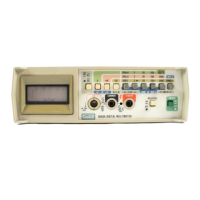OPERATION
AC VOLTAGE/CURRENT MEASUREMENT
1.
Using
the dB function on the
8050A
measure the voltage at
TP1
(or intended
reference).
2.
While measuring the intended reference, set the RELATIVE switch
to
ON.
3.
In
this circuit,
1
mV
becomes the
O
dB reference.
All
subsequent dB measurements
in the circuit are displayed
as
the
loss
or
gain
of
the circuit m dB.
TP1
~
TP2
-
TP3
-
TP4
-
TP5
OdB
-
+60
dB
-
+57.5 dB
-
+74 dB
-
+66dB
(ref)
TP1
TP2
TP3
T 4
T 5
1V
5V
Figure 2-13. dB Circuit Gain or Loss Measurements
2-94.
The 8050A can measure signals with a crest factor
of
3.0
or
less,
at
full scale. Figure
2-15
illustrates some
typical signals and their crest factors. The waveforms in
Figure
2-15
show that a signal with a crest factor
of
greater than
3.0
is
not common.
2-95.
To ensure
that
a signal measured with the 8050A
has a crest factor below 3.0, measure the peak value with
an
ac coupled oscilloscope.
If
the peak value
is
not more
than three times the true-rms reading
of
the 8050A, then
the signals crest factor is
3.0
or less. Another method
of
verifying the error caused by the crest factor
of
a signal
is
to compare the reading
of
the 8050A with a reading on the
next higher range
of
the 8050A. The 8050A crest factor
capability increases from 3.0 for readings less than
full-
scale. The crest factor capabilty
of
the 8050A
is
shown by
the following equation:
Crest Factor Capability
=
3.../
Range
Input
The error caused by exceeding the crest factor
of
3.0
at
full
scale, will
be
reduced significantly on the next higher
measurement range
of
the 8050A . The crest factor
capability at 1
I
IO
scale approaches
10.
2-96.
COMBINED
AC
AND
DC
SIGNAL
MEASURE-
MENTS
2-97.
It
is
sometimes necessary to measure an ac signal
riding on a de level. An example
of
this type
of
signal
is
shown
in
Figure
2-16.
To
obtain
an
accurate
measurement
of
the total rms value for these signals,
perform the following steps:
1.
Measure the ac component
of
the signal using
the AC
V function.
2.
Measure the de component
of
the signal using
the DC
V function.
3.
Use
the following formula with the values
obtained
in
steps 1 and 2 to determine the total
rms value
of
the signal:
Total
RMS
Value
=
v'(ac component
rms)2
+(de
component)2
2-17

